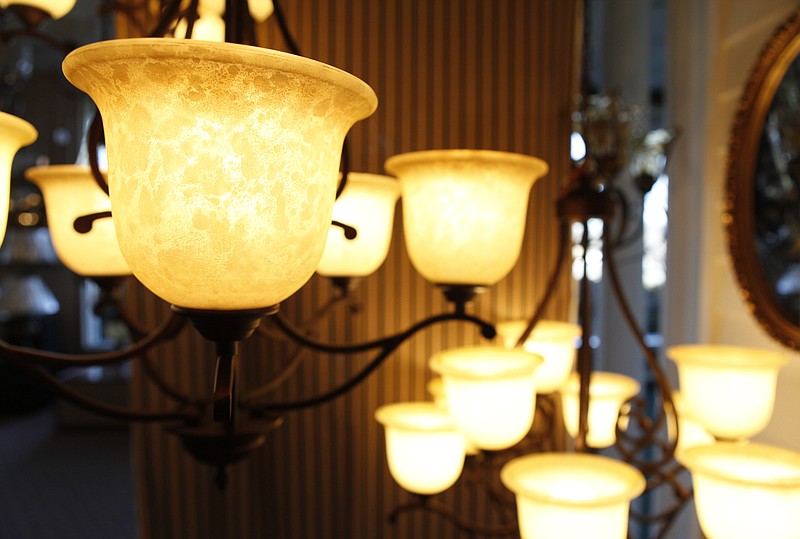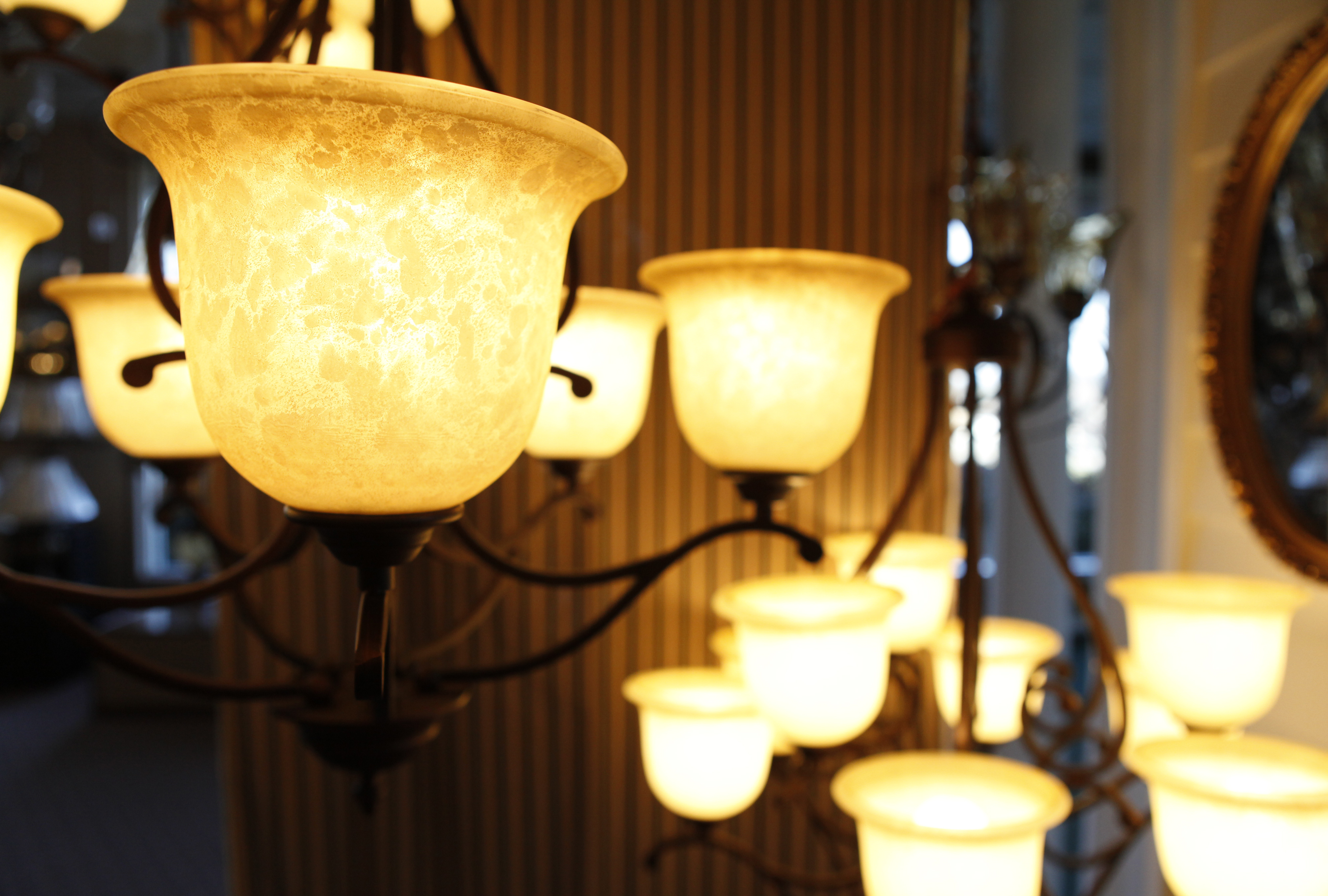Choosing proper lighting for one's home is an ongoing challenge for The Lighting Gallery's interior designer Amy Vetter and sales manager Debbie Maples.
"There is a balance between too much and too little [light], but if I had to do one or the other, I would have too much," Vetter said, noting that most fixtures can be dimmed to help control the amount of light.
Achieving the right balance, Maples said, starts with an understanding of the four sources of lighting: ambient, task, accent and decorative. Here's how it works.
AMBIENT LIGHTING
Use this: As your general source of lighting.
Trends: "Most commonly today, we see home owners requesting recessed can lights to provide the general light," Maples said. "Recessed cans allow lights to be spaced ... where needed without having to navigate around a suspended fixture. The recessed cans all but disappear into the ceiling, leaving a clean look to the room. All you see is the light."
For extra versatility, she recommends adding a dimming switch, which can control the level of light from the cans as well as prolong the life of the bulbs.
TASK LIGHTING
Use this: As light for specific activities, such as reading, cooking, working on a computer, playing games and sewing.
Trends: "In kitchens we specify undercabinet lights, which direct light to the counter surface," Vetter said. "The counter is where a majority of work takes place, so this is where task light is greatly needed.
"But there are other work areas in the kitchen where undercabinet lights would not work because upper cabinets don't exist, like over an Island," Vetter continued. "Here we can use some decorative options like mini pendants or island fixtures, which will direct light down to the surface while also providing decorative lighting."
Specific sources of task lighting vary depending on the application. For example, a very direct source of light would be best for sewing and reading. If looking to add a source to your home, a floor or table lamp would be a quick fix. However, if you are building and you know a specific area that you will use for reading/sewing, you can plan for directional recessed cans. These fixtures are smaller than the typical recessed can and have special trims that allow light to be focused in exact locations.
ACCENT LIGHTING
Use this: To highlight artwork and architectural details.
Trends: Highlighting specific pieces in a home can easily be done with 4-inch recessed cans fitted with specialty trims, such as spot trims or slot trims, which focus the beam of light to a desired location, Vetter and Maples said.
DECORATIVE LIGHTING
Use this: To enhance a room's decor.
Trends: These are often small lamps that double as design elements.
If glare is a problem, use fixtures with shade diffusers or try up lights. An "up" light means the globe on the fixture faces the ceiling. These fixtures provide indirect light, which is much better for the eyes. While indirect lighting does not provide an intense direct light, it does give a good general light source. If more light is needed for a specific need, then additional task lighting would be needed, the experts said.
Also gaining in popularity in new homes are built-in night lights.
"They have a low profile which keeps them from jutting out into a room, and they produce just the right amount of light that can help you navigate through the home at night without having to turn on an overhead light," Vetter said. "Built-in night lights also leave electrical outlets free for other uses. This is especially nice in bathrooms where electrical outlets are limited."
ROOM BY ROOM
Vetter and Maples offer the following tips for lighting one's home indoors and out.
Kitchen: The options for decorative lighting are endless and based primarily on the dimensions of the room and the style of the client. Optimal options include ambient light, in the form of recessed cans or ceiling-mounted fluorescent fixtures; task lights, in the form of undercounter lighting; decorative lighting at tables, islands or peninsulas in the form of mini pendants, mini chandeliers.
Bathroom: Task lights in the form of vanity fixtures are ideal. Many times, because of the bathroom size, the vanity lights might provide the task and the ambient light. If the bath is larger or more compartmentalized, additional light will be needed and can be provided through recessed cans, flush-mounted fixtures or semi-flush fixtures. Selecting these is based mainly on what aesthetic the client is wanting. For the shower, Vetter and Maples suggest a recessed can with a shower lens trim. In keeping with building codes, this type of fixture provides light and ensures the safety of the user. The lens shields the bulb from the shower's spray, protecting the bulbs from shattering.
Bedrooms, living rooms, dens: These rooms have similar lighting needs, Maples said. Typically, general/ambient light in the form of recessed cans is recommended. The experts suggest having recessed cans put on dimming switches for these areas, so that you can set the desired light level. Task lighting in these areas can be table lamps or floor lamps. A third source can come from a light kit on a ceiling fan. Ceiling fans provide a decorative aspect to a space while also supplying air circulation and light.
If televisions or computers are located in these rooms, lighting can be tricky. TVs and computers don't need a light source to be seen; they produce their own light. But if it is the only source of light in a space, it can cause strain for the eyes. Too much light, though, produces glare on the screen. To minimize eye strain and reduce screen glare, place table lamps around the seating area. These lamps will provide a soft, shielded level of light that can be controlled easily.
Recreational areas, playrooms, workshops, closets: These spaces require a lot of light, the professionals said. Many times these areas are secondary spaces, meaning that they are used mostly by the homeowners. Guests don't spend much time here. A simple fluorescent ceiling fixture works beautifully. Fluorescents supply a lot of light and have long lives and use less energy. These spaces are really the only areas that multiple light levels aren't needed. The overhead fluorescent will provide plenty of light for all activities. However, placement of the fixtures is important.
Security, perimeter lighting: Double flood lights on the corners of the home provide ample illumination of the perimeter. Placing a light at all entrances into the home is not only a welcoming site but provides visual security at all doors. These fixtures are often decorative and therefore also serve as an embellishment on the exterior of the home. For more intense exterior lighting, landscape light can be installed. Landscape lighting can add drama and interest to a home, while adding additional safety, such as pathway, patio and deck lighting.

